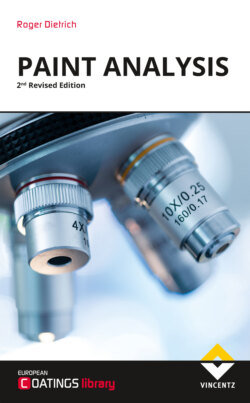Читать книгу Paint Analysis - Roger Dietrich - Страница 5
ОглавлениеInhaltsverzeichnis
1 Foreword
2 Part I General information about paint analysis 1 The surface 2 Why paint analysis? 3 Relevance of modern analytical techniques to paint analysis 4 General considerations 5 Chemical mapping 5.1 Infrared microscopy mapping 5.2 TOF-SIMS imaging 5.3 SEM-EDS mapping 6 Depth profiling 7 Instrumentation
3 Part II Coating failure analysis
4 1 The bumpy road to knowledge
5 2 The analytical procedure 2.1 Inquiry 2.2 Inspection 2.2.1 Macroscopic inspection 2.2.2 Microscopic inspection 2.3 Informed guess 2.4 Instrument selection 2.5 Investigation 2.6 Interpretation 2.7 Iterance 2.8 Implementation 2.9 Incumbency
6 3 The power of sampling 3.1 The role of sampling in the analytical procedure 3.2 Random sampling and representativeness 3.3 Targeted sampling 3.4 Non-destructive sampling 3.4.1 Wipe sampling 3.4.2 Rinse sampling 3.4.3 Abrasive sampling 3.5 Typical sampling failures 3.5.1 Wrong sample collection 3.5.2 Non-representative sampling 3.5.3 Selecting the wrong amount of samples 3.5.4 Application of a wrong sampling procedure 3.5.5 Inappropriate sampling tools and containers 3.5.6 Insufficient storing and shipping of samples 3.6 Microsampling
7 4 Paint failures and their analytical approach 4.1 Some considerations on failure reasons 4.1.1 Insufficient workpiece preparation 4.1.2 Handling failures 4.1.3 Application conditions 4.1.4 Environment and climate 4.2 Investigation of adhesion failures 4.2.1 Delamination due to substrate contamination 4.2.2 Adhesion defects caused by migration processes 4.2.3 Delamination caused by moulding conditions 4.2.4 Delamination due to application faults 4.2.5 Delamination due to insufficient pretreatment 4.3 Paint cratering and “fisheyes” 4.3.1 Cratering caused by contamination of the paint material 4.3.2 Craters and pinholes caused by substrate contaminants 4.3.3 Craters caused by paint additive agglomeration 4.3.4 Cratering caused by the application conditions 4.4 Bubbles and blisters 4.5 Discolouration 4.6 Hazes and stains 4.7 Paint spots 4.8 Orange peel 4.9 References
8 Part III Quality control and process analysis
9 1 Quality control of raw material 1.1 Binders 1.1.1 Identity check 1.1.2 Detection of trace contaminants 1.2 Solvents 1.3 Pigmentsand fillers
10 2 Quality control of paint production 2.1 Analysis of filter residues 2.1.1 SEM/EDS analysis of filter residues 2.1.2 FT-IR analysis of filter residues 2.2 Analysis of fogging residues 2.3 Quality check of finished and semi-finished products 2.3.1 ATR-FT-IR screening 2.3.2 TOF-SIMS analysis 2.3.3 Headspace GC-MS analysis 2.4 Paint quality tests
11 3 Field analysis 3.1 Process analysis of paint shops 3.2 Aerosol analysis 3.3 Operating test 3.4 Sampling of the painting air 3.5 Monitoring of pretreatment steps 3.6 Investigation of the degree of crosslinking in 2-pack paints 3.7 Investigation of paint additive migration 3.8 Marine and aircraft coating inspection 3.9 Handhelds and portables 3.10 References
12 Part IV Methods of coating analysis
13 1 Optical light microscopy 1.1 Extended focus imaging (EFI) 1.2 Differential interference contrast (DIC)
15 3 Infrared spectroscopy 3.1 Physical background 3.2 Characteristic absorptions 3.3 Instrumentation 3.4 Sample preparation 3.5 Spectrum representation 3.6 Quantification 3.7 Data analysis and evaluation 3.7.1 Data processing 3.7.2 Use of databases
16 4 Surface infrared spectroscopy 4.1 ATR-FT-IR spectroscopy 4.1.1 Physical background 4.1.2 Depth of penetration 4.1.3 Information depth 4.1.4 Effective path length 4.1.5 Quantification 4.1.6 Detection limit 4.1.7 Instrumentation 4.1.8 Sample preparation 4.2 Reflection infrared spectroscopy 4.2.1 Physical background 4.2.2 External reflection 4.2.3 Instrumentation 4.3 Diffuse reflection spectroscopy 4.3.1 Physical background 4.3.2 Penetration depth 4.3.3 Influences of variable parameters on the spectrum 4.3.4 Sample preparation 4.3.5 Instrumentation 4.3.6 Quantification 4.3.7 Optimization of the measuring parameters 4.3.8 Repeatability
17 5 Infrared microscopy 5.1 Instrumentation 5.2 Sample preparation 5.3 Infrared microscopy, infrared transmission mode 5.4 Infrared microscopy, reflection mode 5.5 Infrared microscopy, ATR mode 5.6 Line-scan und mapping analysis
19 7 Time-of-flight secondary ion mass spectrometry 7.1 Instrumentation 7.2 Calibration and mass resolution 7.3 Sample preparation 7.4 Spectral evaluation 7.5 Imaging mode 7.6 Quantification 7.7 Summary 7.8 Applications
20 8 Scanning electron microscopy 8.1 Physical background 8.2 Lateral resolution 8.3 Instrumentation 8.4 Sample condition
21 9 Electron microanalysis 9.1 Physical background 9.2 Quantification 9.3 Detection limits 9.4 EDS-Imaging 9.5 Applications
22 10 X-ray photoelectron spectroscopy 10.1 Physical background 10.2 Information depth 10.3 Lateral resolution 10.4 Information retrieval 10.5 Quantification 10.6 Instrumentation 10.7 Applications 10.8 Technical data
23 11 GC-MS 11.1 Physical background of GC 11.2 Headspace 11.3 Data evaluation 11.4 Application
24 12 Thin layer chromatography TLC-ATR-FT-IR 12.1 General principle 12.2 Separation procedure 12.3 Identification 12.4 Performance parameters of selected methods
26 Author
28 Index
